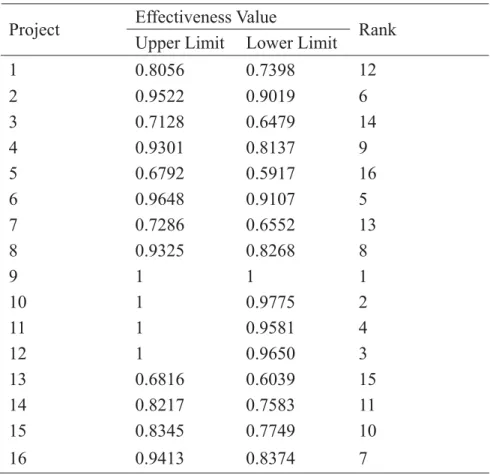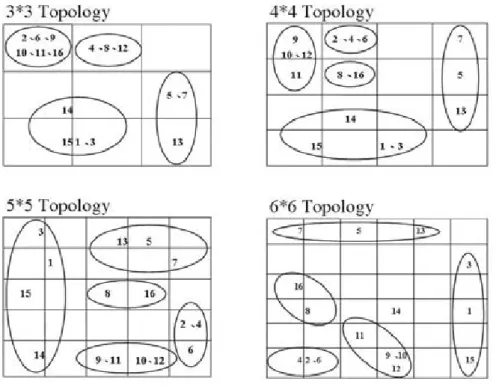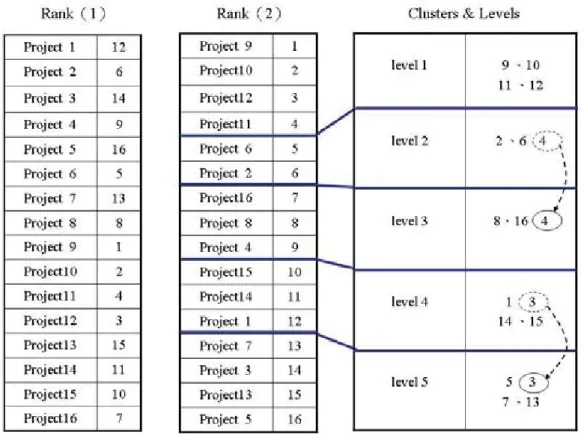Ҷ໕ඳᒧ֟ຑཥБݤ
ڬကী / ੧ / ಷܱѠчѱҥᡏػᏢଣ / ܿࠄࣽמεᏢ / ܿࠄࣽמεᏢ
ABSTRACT
Because the evaluation mechanism is still not complete at present, it is hard to quantify the evaluation indicators and make a proper decision for the tourism development alternatives. With regard to the evaluation methods of a new tourism development project, the related researches were most represented with the Analytical Hierarchy Process (AHP) or the Balanced Scorecard method. Based on the combination of Fuzzy, Data Envelopment Analysis(DEA), and the Self-Organizing Map neural network(SOM), this study develops a Fuzzy DEA-SOM approach for the evaluation of the tourism development alternatives, in which the 16 representative tourism development projects taken in Taiwan are discussed. This study is aimed at establishing the comparison standard of the evaluation level for a new tourism development project. This approach can be an effective tool for the decision-making of a new tourism development project. Once there are new alternatives for evaluating, with this approach, the investor can acquire a reasonable development project correctly.
Keywords: Evaluation; Effectiveness analysis; Neural network; Tourism area
1. INTRODUCTION
The investment willingness of the tourism industry has greatly grown since the implementation of the two-day weekend calendar in Taiwan. However, owing to a huge amount of money and a long-term pay-off period, the related tourism resources and evaluation are more complicated. Because the evaluation mechanism is still not complete at present, it is hard to quantify the evaluation indicators and make a proper decision for the tourism development alternatives.
To deal with the problems mentioned above, this study concentrates on developing a new analysis approach to evaluating the tourism development alternatives, in which the goals of this study are (1) surveying and establishing representative indicators for the evaluation of the tourism development alternatives, (2) constructing a reasonable and useful approach for the evaluation of the tourism development alternatives, (3) building an effective tool to help investors to evaluate and choose a proper tourism development decision, (4) building an information bank which foreign investors can take advantage of the achievements of this study for the tourism development alternatives in Taiwan. The first goal may especially provide investors to pay attention to the indicators, in order to meet the investment profits. The second may assist investors in evaluating and choosing a proper tourism development project.
evaluation in the tourism development alternatives, (2) this study focuses on solving problems which require human knowledge and experience, (3) this study only focuses on tourism development project of the construction budget is between 3 and 60 million U.S dollars, (4) this study is only limited to the exploration of the viewpoints of investors, (5) this study is also confined to a limited number of 16 representative tourism development projects taken in Taiwan. Thus, the practical application of this approach may not be able to comprehensively include every tourism development project.
2. RESEARCH METHOD
With regard to the evaluation methods of a new tourism development project, the related researches were most represented with the Analytical Hierarchy Process (AHP) or the Balanced Scorecard method (Deng, King & Bauer, 2002; Phillips & Louvieris, 2005; Chen, 2006). Nonetheless, when handling weights, AHP and the Balanced Scorecard method have problems, including independent hypothesis and human subjectivity among the indicators. From the literature review about evaluation, it is clear that the evaluation mechanism shows the following phenomena: (1) Most evaluation indicators cannot be quantified. (2) The evaluation process involves multiple indicators, of which the weights cannot be objectively established. (3) The evaluation result has no regularity, so it is not possible to assume a statistical distribution function beforehand. As for Data Envelopment Analysis (DEA), it is a good method when establishing an evaluation mechanism with multiple indicators and the weights cannot be objectively determined (Charnes, Cooper & Rhodes, 1978).
DEA is an evaluation method of multi-input and multi-output, and conforms to the seven features for a good evaluation model (Lewin & Minton, 1986). Since DEA uses mathematical programming to solve the weights of indicators, it is not necessary to decide on the functional relationship. Instead, it is possible to use relative comparisons to decide on the effectiveness values of projects. Additionally, the result obtained via mathematical programming can ensure that it is the optimal solution in the universe. Thus, DEA can be considered worthwhile for application with the evaluation of the tourism development alternatives.
Furthermore, from the viewpoint of the owner (investor), the evaluation value of a project can be defined as the overall project achievement, or goal accomplishment degree under a fixed amount. It means that the input items for DEA must be fixed, and just use the output outcome to analyze the effectiveness of a project. Also, the variable such as “the satisfaction degree of the investor” is a linguistic variable, and is difficult to quantify. Hence, this study introduces Fuzzy Theory in combination with DEA, to develop the Fuzzy Data Envelopment Analysis method (FDEA). Through the fuzzy method, linguistic information of indicators can be converted into data information and the issue of non-quantifiable indicators can be solved.
use.
Pattern classification is one of the main uses for neural networks. Its target is to divide a pattern space into several decision regions, where each decision region represents a category or class. In neural networks, there are many types of models can do the classification, such as SOM, LVQ, ART, and ART-2. With the characteristic of the simplicity and practicability, The Self-Organizing Map neural network (SOM) is the most common network. Therefore, this study uses SOM method to supplement FDEA for the model construction.
However, SOM can neither objectively distinguish clusters on a topological map nor determine the levels of the clusters (Kanges & Kohonen, 1996). It is considered that the rank result of FDEA is a precise solution obtained through mathematical programming. Hence, if FDEA can be used as a reference to revise the cluster result of SOM, then the reasonable classification and the levels can be determined. Based on the combination of FDEA and SOM, this study develops the fuzzy DEA-Neural approach, which can be an effective tool to measure the tourism development alternatives and can help investors to evaluate and choose the optimum tourism development project.
3. APPROACH CONSTRUCTION
3.1 Evaluation Indicators
Based on the combination of Fuzzy, DEA, and SOM, this study develops a Fuzzy DEA-SOM approach for the evaluation of the tourism development alternatives, in which the 16 representative tourism development projects taken by domain experts are discussed. Through the process of literature review and Delphi method, this study established 5 main evaluation indicators (development cost, geographical factors, contents of project merchandise, tourism facilities and securities, and the life cycle of project) and 15 sub-indicators for the evaluation approach. It is shown in Table 1.
Table 1. The Evaluation Indicators
Main indicators Sub-indicators
1. development cost
1.difficulty degree of development 2.resistance degree of local residents 3.development period
4.amount of project
2. geographical factors
1.tracffic conditions of project area 2.climate conditions of project area 3.local related industries of project area
3. contents of project merchandise
4. tourism facilities and securities
1.land amusement facilities and securities 2.waterside amusement facilities and securities 3.aerial amusement facilities and securities 5. the life cycle of project 1.sustainability of project
2.expansibility of project
In this approach, the membership functions of linguistic variables (indicators) are calculated using multi-phase fuzzy statistics. The evaluation data of all the indicators are expressed with the LR method as follows: very satisfied (VS)=(90,100,10,0); satisfied (S)=(75,80,5,10); mediocre (M)=(65,70,5,5); dissatisfied (D)=(55,60,5,5); very dissatisfied (VD)=(0,50,0,5).
3.2 Evaluation Rank of FDEA
Through the FDEA method, the upper and lower limits of the effectiveness of the 16 representative projects can be calculated. When the lower limit is greater, it means that the project (evaluation) is more likely to have a better rank. The evaluation rank of the 16 representative projects is shown in Table 2.
Table 2. The Evaluation Rank of FDEA Effectiveness Value
Project
Upper Limit Lower Limit Rank
3.3 Evaluation Cluster of SOM
Through the SOM method, the evaluation clusters of the 16 representative projects are shown in Figure 1. The 16 projects are divided into 5 clusters (it may be 3, 4, or 6 clusters).
Figure 1. The Evaluation Clusters of SOM
3.4 Evaluation Level of FDEA-SOM
Figure 2. The Evaluation Levels of FDEA-SOM
4. DISCUSSION AND CONCLUSION
This study is aimed at establishing an evaluation approach for a new tourism development project, in which the 16 representative tourism development projects taken in Taiwan are measured as the comparison standard of the evaluation level. In addition, in the process of SOM cluster analysis, the integrality of evaluation classification must be considered in the 16 representative projects. Namely, the 16 representative projects must comprehensively comprise the well evaluation ones, the mediocre evaluation ones, and the poor evaluation ones, which are generally acknowledged by the domain experts. Thus, this approach can offer the evaluation level for a new tourism development project correctly.
difficulty degree of development, resistance degree of local residents, development period, and amount of project, etc.
This approach can be an effective tool for the decision-making of a new tourism development project. Once there are new alternatives for evaluating, with this approach, the investor can acquire a reasonable development project correctly.
REFERENCES
Charnes, A., Cooper, W., & Rhodes, E. (1978). Measuring the Efficiency of Decision Making Units.
European Journal of Operational Research, 2, 429-444.
Chen, C. F. (2006). Applying the Analytical Hierarchy Process (AHP) Approach to Convention Site Selection. Journal of Travel Research, 45, 167-174.
Deng, J., King, B., & Bauer, T. (2002). Evaluating Natural Attractions for Tourism. Annals of
Tourism Research, 29, 422-438.
Kanges, J., & Kohonen, T. (1996). Developments and Applications of the Self-Organizing Map and Related Algorithms. Mathematics and Computers in Simulation, 41, 3-12.
Lewin, A.Y., & Minton, J.W. (1986). Determining organizational effectiveness: another look, and an agenda for research. Management Science, 32, (5), 514-538.
Phillips, P., & Louvieris, P. (2005). Performance Measurement System in Tourism, Hospitality, and Leisure Small Medium-Sized Enterprises: A Balanced Scorecard Perspective. Journal of


